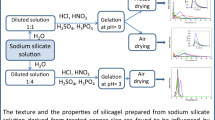Abstract
Phosphate-containing silicate materials prepared using sol–gel method from Si(OC2H5) were investigated at the variation of the amount of phosphate modifier from 5 to 50 wt% in term of P2O5. Chemical composition, textural and structural properties of these materials were characterized by FTIR-spectroscopy, TEM, X-ray diffraction and nitrogen adsorption. It was shown that the materials posse monomodal pore size distribution of 5–20 nm for the samples dried at 100 °C and 40–60 nm for the specimens calcined at 600 °C. The mean pore size and surface area depended on the amount of phosphoric acid. Before the stage of high temperature treatment phosphoric acid, introduced into the structure of the materials as a modifying agent, was uniformly distributed inside a porous space of the material and was not chemically bonded with silicate. After high temperature treatment both chemical interaction of silicate with phosphate, providing the formation of silicate-phosphate structures, as well as redistribution of free modifier from the bulk of granules to their surface took place. The polyphosphate layer is formed on the material surface closing the internal porous space. However, in this case a part of the phosphate modifier remains chemically unbound to SiO2 structure.





Similar content being viewed by others
References
Plotnichenko VG, Sokolov VO, Koltashev VV, Dianov EM (2002) J Non Cryst Solids 306:209–226
Massiot Ph, Centeno MA, Carrizosa I, Odriozola JA (2001) J Non Cryst Solids 29:158–166
Aguiar H, Serra J, Conzaler P, Leon B (2009) J Non Cryst Solids 29:158–166
O’Donnell MD, Watts SJ, Law RV, Hill RG (2008) J Non Cryst Solids 354:3554–3560
Wegner S, van Wullen L, Tricot G (2008) J Non Cryst Solids 354:1703–1714
Shabanova NA, Sarkisov PD (2004) Fundamentals of sol–gel technology nanodispersed silica. Akademkniga, Moscow (in Russian)
Brinker CJ, Scherer GW (1990) Sol–gel science: the physics and chemistry of sol–gel processing. Academic Press, London
Kirik SD, Belousov OV, Parfenov VA, Vershinina MA (2005) Glass Phys Chem 31(4):439–451
Potapov VV, Serdan AA, Kashpura VN, Gorbach VA (2007) Russ J Phys Chem A 81(10):1698–1702
Fidalgo A, Rosa ME, Ilharco LM (2003) Chem Mater 15:2186–2192
Izaak TI, Vodyankina OV (2009) Russ Chem Rev 78(1):77–88
Elisa M, Sava BA, Volceanov A, Monteiro RCC, Alves E, Franco N, Costa Oliveira FA, Fernandes H, Ferro MC (2010) J Non Cryst Solids 356:495–501
Takahashi M, Suzuki M, Miyagawa Y, Ihara R, Tokuda Y, Yoko T, Nemoto T, Isoda SJ (2010) Sol–Gel Sci Technol 54:319–324
Kostrich LN, Mangasaryan NA, Makincian AYa, Kudrova OYa, Dagasheva SM (1983) Colloidal J (in Russian) 45(2):337–340
Panasyuk GP, Ambartsumyan SG, Budova GP, Danchevskaya MN, Smirnov VN (1988) Inorg Mater (in Russian) 24(5):775–779
Kim YE, Tressler RE (1994) J Mater Sci 29:2531–2542
Weeding TL, de Jong BHWS, Veeman WS, Aitken BG (1982) Nature 318:352–359
Massiot Ph, Centeno MA, Gouriou M, Domínguez MI, Odriozola JA (2003) J Mater Chem 13:67–74
Liu HS, Chin TS, Yung SW (1997) Mater Chem Phys 50:1–10
Stan M, Vasilescu A, Moscu S, Zaharescu M (1998) Rev Roum Chim 43(5):425–432
Matsuda A, Kanzaki T, Tatsumisago M, Minani T (2001) Solid State Ionic 145:161–166
Magaev OV, Knyazev AS, Vodyankina OV, Dorofeeva NV, Salanov AN, Boronin AI (2008) J Appl Catal A-Gen 344:142–149
Dorofeeva NV, Knyazev AS, Radishevskaya NI, Salanov AN, Shilyaeva LP, Sudakova NN, Vodyankina OV (2007) Russ J Phys Chem A 81(5):788–793
Karnaukhov AP (1999) Adsorption. The texture of dispersed and porous materials. Nauka, Novosibirsk [in Russian]
Aronne A, Turco M, Bagnasco G, Pernice P, Di Serio M, Clayden NJ, Marenna E, Fanelli E (2005) Chem Mater 17:2081–2090
Acknowledgments
This work was supported by the Federal Program “Scientific and scientific-educational professional community of innovated Russia in 2009–2013”, was partially supported by the Grant of the Ministry for Education and Science of the Russian Federation (contract No. 13.G36.31.0001 dated 07.09.2010), and was financially supported by the Federal target program «Studies and Development of Russia’s Scientific and Technological Priorities for 2007–2013».
Author information
Authors and Affiliations
Corresponding author
Rights and permissions
About this article
Cite this article
Epiphanova, A., Magaev, O. & Vodyankina, O. Formation and characterization of phosphate-modified silicate materials derived from sol–gel process. J Sol-Gel Sci Technol 61, 509–517 (2012). https://doi.org/10.1007/s10971-011-2652-z
Received:
Accepted:
Published:
Issue Date:
DOI: https://doi.org/10.1007/s10971-011-2652-z



